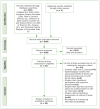Prenatal or Childhood Serum Levels of Vitamin D and Dental Caries in Paediatric Patients: A Systematic Review
- PMID: 32895648
- PMCID: PMC11654605
- DOI: 10.3290/j.ohpd.a45089
Prenatal or Childhood Serum Levels of Vitamin D and Dental Caries in Paediatric Patients: A Systematic Review
Abstract
Purpose: To assess the association between low prenatal or childhood levels of 25-hydroxyvitamin D (25(OH) D) and dental caries experience in children.
Materials and methods: PubMed, B-On, Web of Science, Scopus, and Cochrane Library databases were searched. The inclusion criteria were randomised controlled trials, cohort and cross-sectional studies published between 1998 and 2019; caries outcomes expressed as prevalence or based on the decayed missing and filled index for primary and permanent teeth/surfaces; and vitamin D levels assessed by laboratory analysis. Two authors independently selected studies, collected data, and assessed risk of bias. The quality of the studies was also assessed. A narrative synthesis of the studies was performed without quantitative pooling of data due to clinical and methodological heterogeneity.
Results: Out of 399 studies identified, 13 were included in the data synthesis. Even though many of the included studies had a cross-sectional design, 11 were considered high quality. The studies indicated that vitamin D has an important role in caries experience, but also revealed that vitamin D levels equal to or above 75 nmol/l seem to be more closely related to caries experience than the reference value of the Institute of Medicine.
Conclusion: Evidence of an association exists between low 25(OH) D levels (<75 nmol/l) and caries experience in children. Hence, low vitamin D levels should be considered a potential factor associated with caries in children. Clinicians should be aware that good prenatal nutrition and early childhood diet might influence caries experience.
Keywords: 25-hydroxyvitamin D; children; dental caries; preventive dentistry; vitamin D.
Figures
References
-
- Almoudi MM, Hussein AS, Hassan MIA, Schroth RJ. Dental caries and vitamin D status in children in Asia. Pediatr Int. 2019;61:327–338. - PubMed
-
- Bener A, Al Darwish MS, Hoffmann GF. Vitamin D deficiency and risk of dental caries among young children: A public health problem. Indian J Oral Sci. 2013;4:75–82.
Publication types
MeSH terms
Substances
LinkOut - more resources
Full Text Sources
Medical



